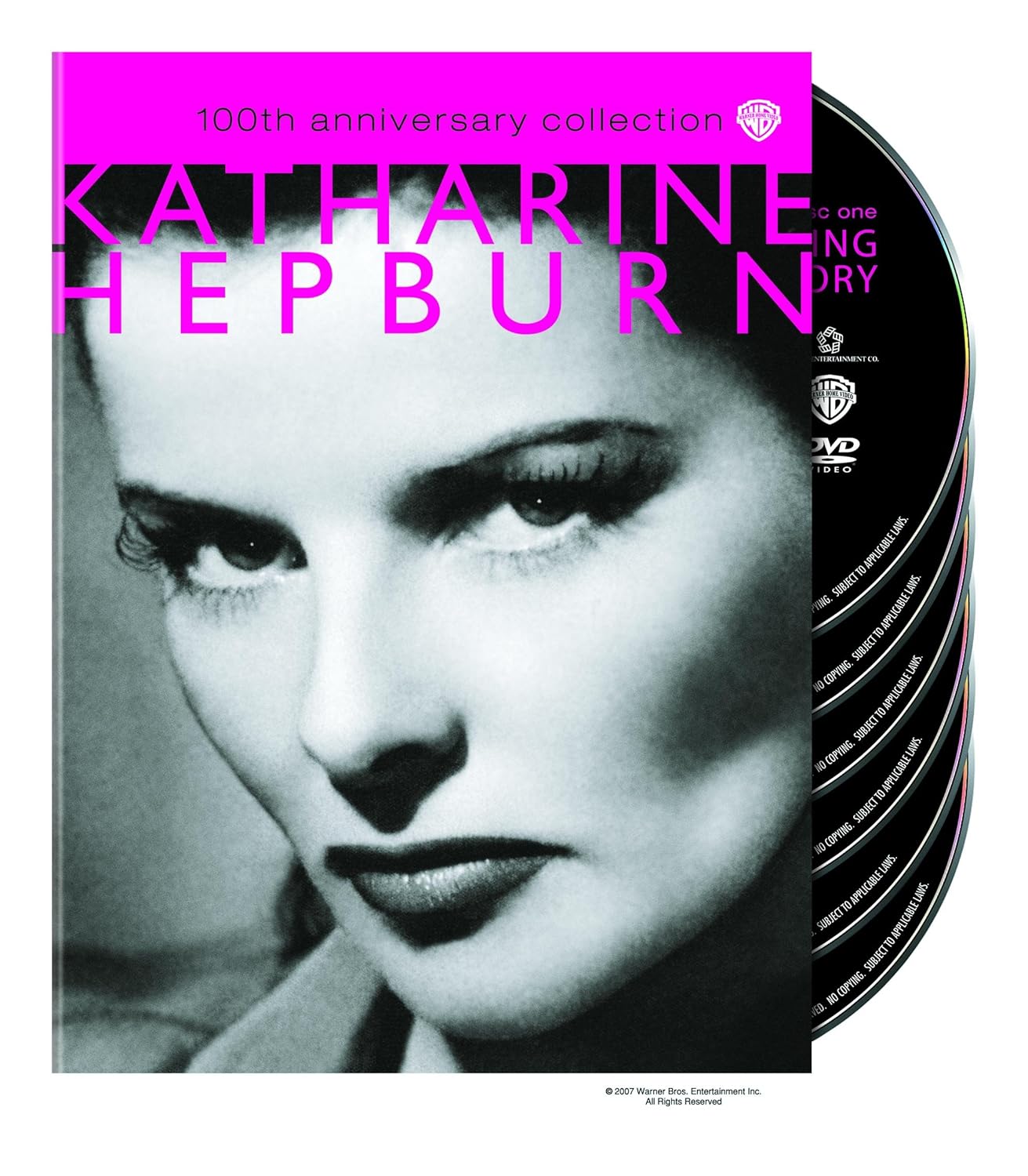Note: Just for the record, I’ve already written at one time or another for this site about Hallelujah, I’m a Bum!, Judge Priest, Love Me Tonight, M, The Man Who Could Work Miracles, Pilgrimage, and Vampyr — which is the only reason why I’m not doing so now.So add these seven titles to all of those found below (listed alphabetically) and you’ll have 28 recommendations in all. And even this list is very far from exhaustive. For instance, I haven’t even mentioned Sacha Guitry, the witty playwright-filmmaker-actor whose cinematic “golden age,” 1936-1938, comprising no less than nine features (my favorite is the trilingual The Pearls of the Crown), are all available with English subtitles in one gigantic box set issued in France by Gaumont, Sacha Guitry L’Age d’or 1936-1938. But don’t get me started… (NOTE: HYPERLINKS ARE ON TITLES, COVERS or BOLD, MAROON, UNDERLINED TEXT) 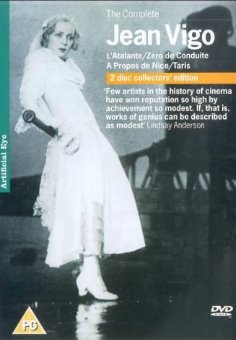
| |
L’Atalante. Jean Vigo’s only full-length feature (1934, 89 min.), one of the supreme masterpieces of French cinema, was edited and then brutally re-edited while Vigo was on his deathbed, so a definitive restoration is impossible. But the one carried out in 1990 is probably the best and most complete we’ll ever be able to see, and it’s a wonder to behold. The simple love-story plot involves the marriage of a provincial woman (Dita Parlo) to the skipper of a barge (Jean Dasté), and the only other characters of consequence are the barge’s skeletal crew (Michel Simon and Louis Lefebvre) and a peddler (Gilles Margaritis) who flirts with the wife at a cabaret and describes the wonders of Paris to her. The sensuality of the characters and the settings, indelibly caught in Boris Kaufman’s glistening cinematography, are only part of the film’s remarkable poetry, the conviction of which goes beyond such categories as realism or surrealism, just as the powerful sexuality in the film ultimately transcends such categories as heterosexuality, homosexuality, and even bisexuality. Shot by shot and moment by moment, the film is so fully alive to the world’s possibilities that magic and reality seem to function as opposite sides of the same coin, with neither fully adequate to Vigo’s vision. |
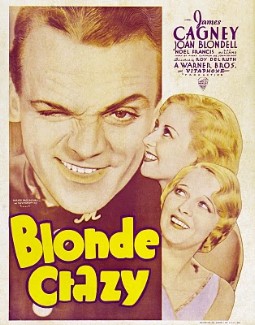 |
| Blonde Crazy. The credited director of this 79-minute feature about scrambling con artists is Roy Del Ruth, a solid company man at Warners. But the true auteurs here are the brilliantly proactive and expressive costars, James Cagney and Joan Blondell — as aided and abetted by the screenwriting team of John Bright and Kubec Glasmon, who worked on at least half a dozen other Cagney vehicles during this period (not to mention just as many Blondell features, including the underrated Union Depot). Packed with loads of plot twists and saucy repartee, this unassuming comedy-drama probably offers more Depression flavor than any other item in this survey apart from the corrosive Man’s Castle, and it’s strictly an oversight that this hasn’t yet come out on DVD. |
|
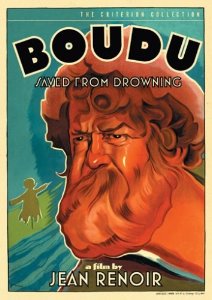 |
|
Boudu Saved from Drowning. The 30s was an especially strong period for Howard Hawks (represented by two films here), for Ernest Lubitsch (also represented by two films), for Leo McCarey (ditto), and, most of all, for Jean Renoir (represented by three), who turned out 13 features during that decade, the second, third, and thirteenth of which are cited here. Boudu (1932), the third, stars the great Michel Simon (see L’Atalante, above) as a mangy and unapologetic tramp saved from drowning by a middle-class Parisian bookseller who’s determined to reform and “civilize” him. A ruthless and often hilarious tweaking of liberal delusions that scandalized Bosley Crowther, lead film reviewer of the New York Times, so thoroughly when it opened in the U.S. for the first time (in 1967!) that he walked out before the end, it continues to charm and provoke. (By contrast, Paul Mazursky’s toothless 1986 remake, Down and Out in Beverly Hills, offends only those who care about the original.) Renoir’s light-hearted comedy is also a kind of irreverent celebration of Boudu’s sloth, diffidence, and instinctually animalistic behavior. Renoir’s off-the-cuff manner of shooting remains as carefree and as fresh as the lead character. |
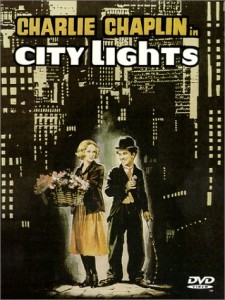 |
| City Lights. My favorite Charlie Chaplin feature (1931) — his first sound picture, but not, properly speaking, his first talkie–is also probably the one on which he exercised the most patience and perfectionism, with almost two years of shooting, countless retakes, and a recasting of the female lead (with Georgia Hale, his female lead in The Gold Rush, eventually replaced by Virginia Cherrill, who was herself subsequently fired and rehired, as the blind flower-selling street waif who believes Chaplin’s Tramp is a millionaire). It’s also quite likely the Chaplin feature that can boast the best DVD extras, including one brilliant seven-minute gag sequence that Chaplin deleted because it interfered with the film’s overall architecture. Interestingly enough, and significantly, the tragic final sequence, in close-ups, rightly regarded as the most emotionally wrenching sequence in Chaplin’s career, is edited in such a way that it has glaring continuity errors, none of which matter in the slightest because of the power of his performance. |
|
 |
|
Dishonored. My favorite among the seven glittering Josef von Sternberg features starring Marlene Dietrich, all of them made between 1930 and 1935, is ironically the least well known, and currently available only as a Swedish import, although Jean-Luc Godard once included it in a list of his ten favorite American films. It’s the second American film Sternberg made with Dietrich, although it was completed before he released the first (Morocco), and in some ways it’s the most stylistically perfect of all his sound features. In it, Dietrich plays X-27, a character clearly inspired by Mara Hari — an Austrian prostitute whose patriotism leads her to agree to spy on the Russians (in particular, Victor McLaglen) and whose activities ultimately lead to her death by firing squad. |
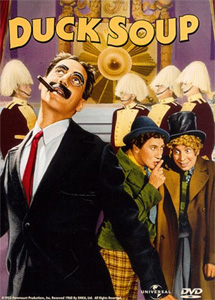 |
Duck Soup. From my favorite Sternberg to my favorite Marx Brothers is less of a leap than it might initially appear to be, especially because both deal with national issues in abstract and rather absurdist terms. Leo McCarey’s only encounter with Chico, Groucho, Harpo, and Zeppo is memorable for many other reasons: it has fewer distractions (i.e., gratuitous musical and romantic sequences) than any of the other Marx Brothers movies, more purely visual delights with links to silent cinema (above all, the sequence with multiple Grouchos), and as a wholesale ridicule of everything that leads to and justifies warfare, it has the most bite as satire as well as the most free-wheeling spirit..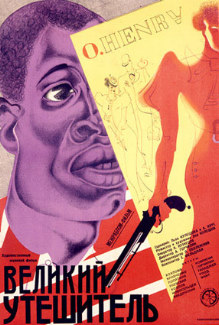 |
|
|
The Great Consoler and Ivan. I’m cheating a little here by including in a single slot my two favorite early-sound Soviet pictures, both still woefully unavailable on DVD. (Thankfully, some other innovative gems from this period are available now, such as Boris Barnet’s Outskirts, Vsevolod Pudovkin’s Deserter, and Dziga Vertov’s Enthusiasm.) Both are pretty wild and adventurous, but the first of these (1933), by Lev Kuleshov, is a true mind-boggler. It leaps freely between three blocks of material: (1) In prison for embezzlement, William Sydney Porter, better known as O. Henry, is persuaded by the warden to convince a fellow prisoner, safecracker Jimmy Valentine, to open a locked bank safe without explosives in order not to destroy the papers inside, after the banker, who knows the combination, skips town with the funds. Valentine can do this only by painfully filing down his fingernails to sensitize his fingers, but the warden promises to grant him a pardon in return. Meanwhile, Porter is so impressed by Valentine’s skill that he writes a famous short story, “A Retrieved Reformation,” romanticizing Valentine’s heroic exploits. But then the warden, reneging on his promise, refuses to release Valentine, forcing Porter to realize in despair that he and Valentine have both been exploited. (2) “A Retrieved Reformation,” recounted in parody form, as a Russian-style western. (3) The effect of this story on one reader, Dulcie (Alexandra Khokhlova, Kuleshov’s wife), a shopgirl who is being forced to prostitute herself by the same cop who convinced the prison warden to exploit Valentine’s gifts. Even though Porter’s escapist yarn falsifies the truth, it also inspires Dulcie to shoot the cop when he tries to exploit her in turn….Ivan (1932), the first talkie by the great Ukrainian filmmaker Alexander Dovzhenko and a rapturous audiovisual poem, supposedly celebrates the building of a huge dam on the Dnieper River but never even bothers to show us the completed structure; there are three separate characters named Ivan in the picture and a great deal of wonderful comedy….Both these masterpieces were unjustly denounced in Russia as “formalist” when they came out, but that’s certainly no excuse for Westerners to ignore them today. 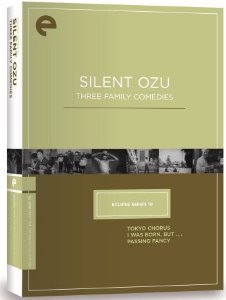 |
|
| I Was Born, But…, Tokyo Chorus, and Passing Fancy. Another form of cheating is to list all three of these late silent pictures of Yasujiro Ozu, usefully packaged together with optional piano scores by Criterion as “Eclipse Series 10: Silent Ozu — Three Family Comedies”. And the only reason why I’m listing I Was Born, But… (1932) first, before Tokyo Chorus(1931), is that it’s my favorite Ozu film, full stop, even though the other two aren’t far behind. My only complaint about the packaging of these three masterpieces is that calling them simply “family comedies” short-changes them, even though all three certainly have their hilarious moments. (In fact, the opening sequence of the 1933 Passing Fancy may be the funniest piece of slapstick Ozu ever filmed. At a public music and storytelling performance, a stray purse is surreptitiously picked up, investigated, and then discarded by a succession of people in the audience, who toss it around like a beanbag — a string of repetitions that overlaps with a series of frenetic dances performed by many of the same people when they’re bitten by fleas.) To call them all “family comedy-dramas” might come closer to the mark, but this label is also inadequate: Passing Fancy, which was inspired in part by King Vidor’s The Champ (1931), basically focuses on a day laborer who’s a single parent and his son, a duo rather than a family per se. The two are both played by Ozu regulars, Takeshi Sakamoto (who in fact plays in all three features) and Tokkan Kozo (who also plays in I Was Born, But…) And it’s also worth emphasizing that Tokyo Chorus and Passing Fancy are both quintessential Depression films.
|
|
|
Make Way for Tomorrow. Due out from Criterion later this month, Leo McCarey’s 1937 heartbreaker, a particular favorite of Orson Welles, didn’t win any Oscars, but when McCarey won an Oscar the very same year for another movie, The Awful Truth, he tactfully suggested in his acceptance speech that the Academy might have given it to the wrong picture. There’s arguably no other film ever made anywhere that deals more nakedly and candidly with the mistreatment of old people (although Yasujiro Ozu’s best-known feature, Tokyo Story, was clearly influenced by it), and McCarey being McCarey, this subject is milked for laughs as well as tears. It’s also one of the most romantic movies ever made in Hollywood, and the mounting tragedy of the final act is devastating. The focus is on an elderly couple (Victor Moore and Beulah Bondi) whose children don’t know what to do with them, and rather than simply castigate them for their cluelessness, McCarey understands their dilemma as well as the situation of their parents; with Fay Bainter, Thomas Mitchell, and Porter Hall. |
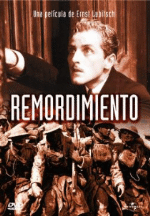 The Man I Killed aka Broken Lullaby. Technically available from Spain, but not at all easy to come by (and available only under its rerelease title), Ernst Lubitsch’s atypical antiwar film (1932), the first movie he ever cowrote with the great Samson Raphaelson, follows a French soldier in World War ( the unjustly forgotten Phillips Holmes) who is so stricken about the German soldier he killed in the trenches that he travels to the dead man’s village and meets his family. Only 76 minutes long, this has much the same elliptical style, exquisitely detailed and articulated, that Lubitsch brought to his better-known romantic comedies and musicals, but the directness and sincerity of the story apparently disconcerted audiences at the time. No matter: the sentiments expressed are not in the least bit dated today. With Lionel Barrymore and Nancy Carroll. The Man I Killed aka Broken Lullaby. Technically available from Spain, but not at all easy to come by (and available only under its rerelease title), Ernst Lubitsch’s atypical antiwar film (1932), the first movie he ever cowrote with the great Samson Raphaelson, follows a French soldier in World War ( the unjustly forgotten Phillips Holmes) who is so stricken about the German soldier he killed in the trenches that he travels to the dead man’s village and meets his family. Only 76 minutes long, this has much the same elliptical style, exquisitely detailed and articulated, that Lubitsch brought to his better-known romantic comedies and musicals, but the directness and sincerity of the story apparently disconcerted audiences at the time. No matter: the sentiments expressed are not in the least bit dated today. With Lionel Barrymore and Nancy Carroll.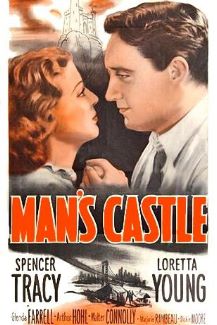 |
|
|
Man’s Castle Considering the deluxe job done with the dozen-disc “Murnau, Borzage and Fox,” it’s rather stupefying to reflect that Frank Borzage’s most potent sound picture remains unavailable everywhere [except for a Spanish DVD and YouTube]. But this was a movie made at Columbia, not Fox, and apparently not even the star power of Spencer Tracy suffices to put this item on the market. He plays a spiky scrambler in Manhattan during the Depression opposite an equally homeless Loretta Young. The two wind up living together in a Hooverville shack (alluded to in the film’s ironic title) where she becomes pregnant, and I suspect that at least part of the problem may be the eroticism (including some brief nudity) and the complete lack of sentimentality that have always made this a beleaguered picture. It was certainly a commercial flop. Over 30 censorship cuts were made even before the film was released, and this didn’t prevent some critics from complaining about the harshness of what remained. “This is the saga of a roughneck you wouldn’t put up in your stable,” the Variety reviewer complained. “The horses might complain. Spencer Tracy is cast in his most distasteful role.” And in fact, Tracy’s character seems almost benign alongside his neighbor, played by Marjorie Rambeau, who shoots a would-be rapist and a police snitch with the line, “This ain’t murder, this is just house cleaning.”
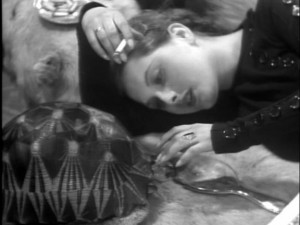 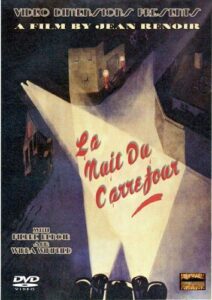
|
La nuit du carrefour. To the best of my knowledge, Jean Renoir’s low-budget adaptation of a Inspector Maigret mystery by Georges Simenon—a novel available in English as Maigret at the Crossroads–remains so obscure outside of France that it’s never even been subtitled in English, and you can’t (yet) even find it on DVD there. [2018: Happily, neither of these conditions still holds–although the English subtitled DVD, available from Amazon, is rather pricey.] But this highly atmospheric noir, set around a garage in the grubbiest of Parisian suburbs, is without a doubt the most erotic movie Renoir ever made, thanks mainly to the Danish actress Winna Winifried, who plays a major role as a druggy femme fatale named Else Andersen (and who appeared in only half a dozen French and English films after this one, all of them even more obscure). Renoir’s brother Pierre plays Maigret, nearly all of the action occurs at night, and part of what’s so exciting about the film, in spite of its confusing plot (apparently occasioned by one of the reels being lost), is the use of direct sound, especially in conjuring up an intricate sense of offscreen space. This was Renoir’s second talkie feature after La Chienne, and significantly the opening credits highlight the various noises in a garage as if they were stretches of musique concrète. Godard has celebrated La nuit du carrefour as Renoir’s most mysterious film, as well as the greatest of all French police thrillers. 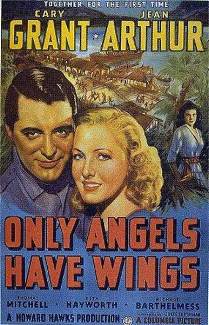 |
|
|
Only Angels Have Wings. Honest and profound hokum may sound like a contradiction in terms, but I can’t think of a better way to describe Howard Hawks’ unlikely yet beautiful and thrilling masterpiece (1939) about daredevil pilots in a remote South American port who risk their lives delivering the mail across a threatening mountain pass. The sense of void and impending, meaningless death that surrounds and encloses all the banter, braggadocio, and risk-taking makes this seem like the most existential of Hawks’ adventures. Cary Grant–once described by Dave Kehr in this film as “the high priest of some Sartrean temple”–is the group’s fatherly boss, Thomas Mitchell his best friend, Jean Arthur the showgirl who sticks around because of her love-struck devotion, and Sig Ruman plays Dutchy, the uncle type who runs the bar connected to the small airport. The uncannily expressive silent star Richard Barthelmess plays the returning pilot who once caused the death of a copilot due to cowardice, and Rita Hayworth plays his newlywed wife, an old flame of Grant’s. The precise sense of ethics governing all the interactions between this motley crew is as striking as the artificiality of the settings. 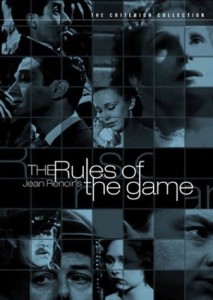 |
The Rules of the Game. Virtually everyone agrees that this is Jean Renoir’s supreme masterpiece, made and released the same year as Only Angels Have Wings and even more of a virtuoso ensemble work. Yet this was so adroit in catching the troubled zeitgeist of France at the time that it was loathed by audiences at the time of its release, making it the biggest flop of Renoir’s career. Only many years later, after it was painstakingly restored and reconstructed, was its greatness seen and acknowledged. Mostly set in a country chateau over a single weekend, where the crisscrossing romantic intrigues of both guests and servants play out in intricate counterpoint, culminating in a costume party, Renoir joins the proceedings as a major actor and character as well as writer-director, attempting to serve as go-between between two of his most intimate friends, the wife (Nora Grégor) of the Jewish marquis (Marcel Dalio) who’s hosting the weekend and the lovesick but rejected famous pilot (Roland Toutain) who wants to run away with her. As a view of French society in 1939, this tragicomic farce is both scathingly satirical and warmly compassionate, though it was plainly only the scathing satire that most members of the contemporary audience responded to.
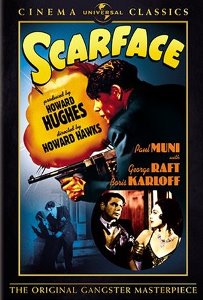 |
Scarface. My all-time favorite gangster film, put together like a macabre black comedy that eventually veers into something very close to Greek tragedy (complete with brother-sister incest), Howard Hawks’ uncharacteristic masterpiece beats out the Godfather features in at least one major respect: it is completely unsentimental about both crime and violence. (Among the half-dozen credited and uncredited hands who worked on the brittle script are Ben Hecht, W.R. Burnett, and Hawks himself.) The movie is in fact so blunt (Howard Hughes, the producer, always had a taste for scandalizing his audience) that it had endless battles with censors, a few of which it lost, yet its anarchic spirit shines through triumphantly in spite of everything. (The only concession—a stupid dialogue scene among Concerned Citizens—clearly belongs to a different picture.) Paul Muni’s galvanic screen debut in the title role, Tony Camonte, a lout with a distinct resemblance to Al Capone, plays him like an innocent caveman, at once charming and terrifying. And the secondary cast—Ann Dvorak, Karen Morley, Boris Karloff, George Raft (another memorable debut, featuring his signature coin-flipping), Vince Burnett (as an illiterate secretary who makes Tony Camonte seem like an intellectual), Osgood Perkins (father of Anthony)—bristles with uncommon, manic energy. Note: every time some gets bumped off in this movie, which is pretty often, an X appears somewhere on the screen, and the placements of these markers are both ingenious and unnerving. |
|
|
| Story of the Late Chrysanthemums. My favorite feature by the great Kenji Mizoguchi is lamentably available at present only in French and Spanish editions, as Contes des chrysanthèmes tardifs and Historia del último crisantemo, respectively — a situation that’s bound to change eventually [2018: IT HAS! SEE PHOTO], because I’m far from alone in my reverence for this film, even in the English-speaking world. Oddly enough, the tragic plot, set in the late 19th century, is very close to that of a backstage musical such as There’s No Business Like Show Business, at least in its initial setup. The hero, the adopted, spoiled, arrogant, sixth-generation heir of a famous and very successful Kabuki actor in Tokyo, is still immature as a performer, but the only one with the guts to tell him so to his face is a family maid and wet nurse whom he immediately falls in love with because of her honesty and sincerity. (Miraculously, all this occurs during one virtuoso lengthy take that accompanies the two of them walking home from the theater, a shot in perpetual motion.) The maid then gets fired by the hero’s wife, and when he disobeys his father’s order to stop seeing her, he gets banished as well. They leave for Osaka, where he struggles for years as an actor with her support and eventually joins a traveling company. When he’s eventually invited to rejoin his father, he’s forced to part company with his lover, whom he sees again only on her deathbed, after he’s become famous and celebrated. Part of what’s so remarkable about this film’s two-part structure is the way Mizoguchi repeats the same camera angles in scenes that occur years apart, in the same settings, to stir our memories almost subliminally.
|
|
|
Sylvia Scarlett. For me, this bizarre and poetic 1935 feature that tanked at the box office, is also in many ways the most interesting and audacious movie George Cukor ever made. Katharine Hepburn disguises herself as a boy to escape from France to England with her crooked father (Edmund Gwenn); they fall in with a group of traveling players, including Cary Grant (at his most Cockney); the ambiguous sexual feelings that Hepburn as a boy stirs in both Grant and Brian Aherne (an aristocratic artist) are part of what makes this film so subversive. Sudden shifts in genre match the equally sudden shifts in gender as the film disconcertingly changes tone every few minutes, from farce to tragedy to romance to crime thriller–-rather like some of the French New Wave films (e.g., Breathless and Shoot the Piano Player) that were to come a quarter century later. Cukor’s usual fascination with theater and the self-images of women, assisted by his expert cast, somehow holds everything together. The great English short story writer John Collier collaborated on the script, and Joseph August did the evocative cinematography. 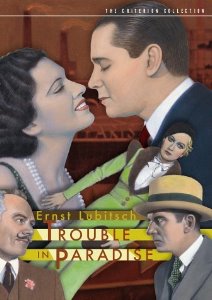 |
| Trouble in Paradise. By general agreement, this is Lubitsch’s most perfect comedy, beautifully paced and acted and edited and spoken, and it’s so graceful and seemingly effortless that you can mainly only feel the Depression leaking through the pauses and around the edges of the plot. It’s also quite possibly Lubitsch’s most complex picture, because, as in Renoir’s movies, every character has his or her own reasons, and everyone invariably knows and thinks more than he or she is saying. Herbert Marshall and Miriam Hopkins are a couple of gifted thieves and con artists who meet and fall in love in Venice while attempting to fleece one another. After they join forces, they go to work on an heiress who runs a cosmetics factory in Paris (Kay Francis), with Marshall serving as her secretary, but their prey seems to know at times that she’s being robbed and doesn’t exactly mind, and he’s more than a little ambivalent about his work as well. The film also makes room for Charles Ruggles and Edward Everett Horton as a couple of romantic rivals and well-to-do stooges who are pursuing the heiress as well; the screenplay is by Samson Raphaelson and Grover Jones. |
|
|

















